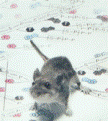Papers in the Biological Sciences

Jay F. Storz Publications
Document Type
Article
Date of this Version
10-15-2013
Citation
Am J Physiol Regul Integr Comp Physiol. 2013 Oct 15; 305(8): R961–R967.
Abstract
When freshwater turtles acclimatize to winter hibernation, there is a gradual transition from aerobic to anaerobic metabolism, which may require adjustments of blood O2 transport before turtles become anoxic. Here, we report the effects of protons, anionic cofactors, and temperature on the O2-binding properties of isolated hemoglobin (Hb) isoforms, HbA and HbD, in the turtle Trachemys scripta. We determined the primary structures of the constituent subunits of the two Hb isoforms, and we related the measured functional properties to differences in O2 affinity between untreated hemolysates from turtles that were acclimated to normoxia and anoxia. Our data show that HbD has a consistently higher O2 affinity compared with HbA, whereas Bohr and temperature effects, as well as thiol reactivity, are similar. Although sequence data show amino acid substitutions at two known β-chain ATP-binding site positions, we find high ATP affinities for both Hb isoforms, suggesting an alternative and stronger binding site for ATP. The high ATP affinities indicate that, although ATP levels decrease in red blood cells of turtles acclimating to anoxia, the O2 affinity would remain largely unchanged, as confirmed by O2-binding measurements of untreated hemolysates from normoxic and anoxic turtles. Thus, the increase in blood-O2 affinity that accompanies winter acclimation is mainly attributable to a decrease in temperature rather than in concentrations of organic phosphates. This is the first extensive study on freshwater turtle Hb isoforms, providing molecular evidence for adaptive changes in O2 transport associated with acclimation to severe hypoxia.


Comments
Copyright © 2013 the American Physiological Society. Used by permission.